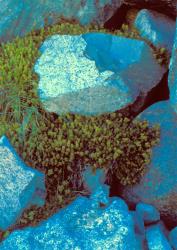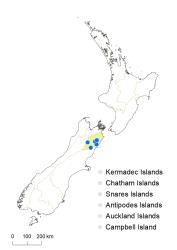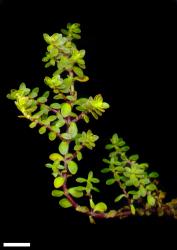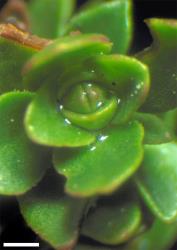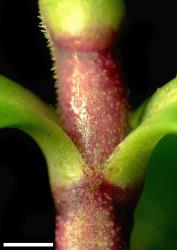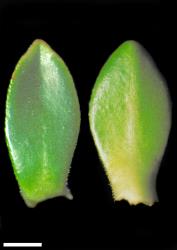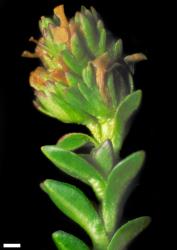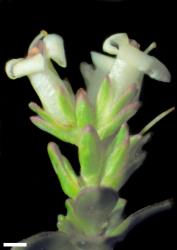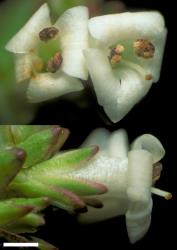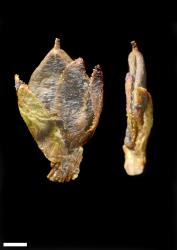- ≡ Hebe ramosissima G.Simpson & J.S.Thomson, Trans. & Proc. Roy. Soc. New Zealand 72: 29 (1942)
- ≡ Leonohebe ramosissima (G.Simpson & J.S.Thomson) Heads, Bot. Soc. Otago Newsl. 5: 7 (1987)
Sub-shrub or spreading low shrub to 0.15 m tall. Stems decumbent, eglandular-pubescent; hairs bifarious. Leaf bud distinct, its outer leaves fully grown, diverging. Leaves opposite-decussate to sub-distichous, connate in pairs and encircling stem, erecto-patent when young, becoming spreading to recurved; lamina coriaceous, narrowly obovate, sometimes elliptic to obovate to rhomboid, 3.3–9.5 mm long, 1.5–5.5 mm wide, dull to somewhat glossy, green to dark green above, green beneath; midrib obscure, slightly thickened beneath; surfaces glabrous; margin glabrous or sparsely glandular- and eglandular-ciliolate, especially at base and petiole, entire; apex acute to rounded; base cuneate; petiole indistinct, 0.5–1.5 mm long. Inflorescence a terminal compound spike, 8–20 mm long; flowers crowded, 6–20 per inflorescence in terminal and 0–4 lateral spikes, female or bisexual on separate plants, ⚥ > ♀; bracts opposite-decussate and connate or free below, the lowermost sometimes sterile, becoming alternate above, elliptic, ovate, or oblong, < calyx; pedicels absent. Calyx lobes 4, sub-acute to obtuse, 2.0–3.5 mm long, unequal, with mixed, very short eglandular and minute glandular cilia. Corolla 3–6 mm diameter; tube white, 2.8–3.5 mm long, < calyx, glabrous; lobes 4, white, sub-erect to recurved, sub-equal, ovate, orbicular, or rhomboid, 3–4 mm long, obtuse; nectar guides absent. Stamen filaments white, 0.5–1.0 mm long; anthers magenta. Style glabrous, 2–4 mm long. Capsules latiseptate, acute, glabrous, 3.7–4.0 mm long, 1.8–3.0 mm at widest point. Seeds ellipsoid, flattened, smooth, pale brown, 0.7–0.8 mm long.
V. kellowiae plants are most similar to V. macrocalyx in growth form, leaf shape and overall appearance, but V. macrocalyx plants differ in having usually more spikes (up to 12) per inflorescence, and usually a longer calyx that exceeds the corolla tube. The few-flowered inflorescences also distinguish V. kellowiae from other “Connatae”. V. petriei plants also seem similar in their growth form and long corolla tubes, but differ in having leaves minutely puberulent on the adaxial surface near the base, spiralled bracts, many of them sterile at the base of the inflorescence, stalked flowers, and a longer calyx and corolla.
South Island: Marlborough (Inland Kaikōura Range); Canterbury (Seaward Kaikōura Range, Mt Terako).
Alpine rocks and scree, often in moist places. Recorded elevations range from 1200 to 2652 m.
Flowers: December–February; fruits: December–March.
2n = 42 (see Bayly & Kellow 2006, as Hebe ramosissima).
Veronica kellowiae is classified in V. subg. Pseudoveronica sect. Hebe and the informal group “Connatae” (Albach & Meudt 2010; Bayly & Kellow 2006), related to V. epacridea, V. haastii, and V. macrocalyx, according to phylogenetic analyses of ITS sequence data (Wagstaff et al. 2002).



